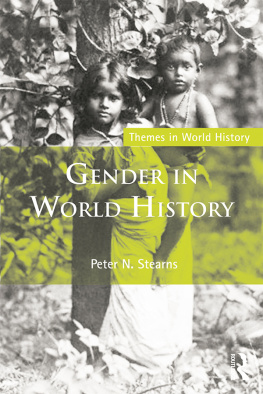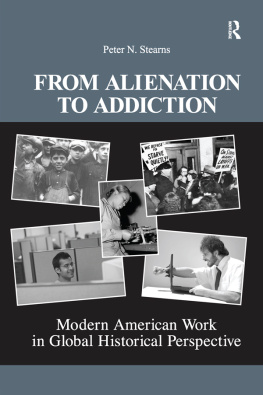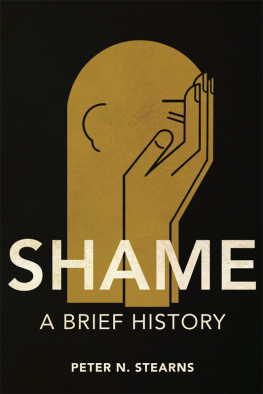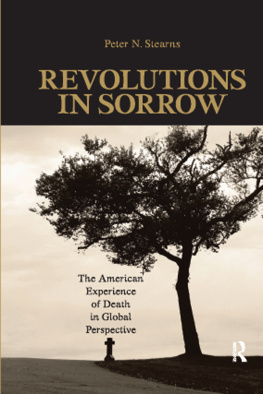Thank you for buying this ebook, published by NYU Press.
Sign up for our e-newsletters to receive information about forthcoming books, special discounts, and more!
Sign Up!
About NYU Press
A publisher of original scholarship since its founding in 1916, New York University Press Produces more than 100 new books each year, with a backlist of 3,000 titles in print. Working across the humanities and social sciences, NYU Press has award-winning lists in sociology, law, cultural and American studies, religion, American history, anthropology, politics, criminology, media and communication, literary studies, and psychology.
Battleground of Desire
NEW YORK UNIVERSITY PRESS
New York and London
1999 by New York University
All rights reserved
Library of Congress Cataloging-in-Publication Data
Stearns, Peter N.
Battleground of desire : the struggle for self-control in
modern America / Peter N. Stearns.
p. cm
Includes bibliographical references (p. ) and index.
ISBN 0-8147-8128-4 (alk. paper)
1. United StatesSocial life and customs20th century.
2. Self-controlUnited StatesHistory20th century. 3. United
StatesSocial life and customs19th century.
4. Self-controlUnited StatesHistory19th century. I. Title.
E169.12.S82 1999
306.0973dc21
99-6177
CIP
New York University Press books are printed on acid-free paper,
and their binding materials are chosen for strength and durability.
Manufactured in the United States of America
10 9 8 7 6 5 4 3 2 1
CONTENTS
ONE
The Heart of the Matter
TWO
Models and Guidelines
THREE
The Victorian Style
FOUR
Transitions
FIVE
Causation
SIX
New Combinations
SEVEN
Sexuality
EIGHT
The Body and Health
NINE
Addiction and Disease
TEN
Conclusions
ELEVEN
An Agenda for Evaluation and Change
PREFACE
I really lost it is a phrase we often hear and use today. The it may refer to our temper, our mastery over grief, or another currently expected inhibition. We might use this expression when apologizing for deviating from standard restraints, angling for approval, or warning our listener against provocations that could result in a similar outburst. Whatever its intent, the phrase recognizes some kind of impulse control as part of social relationships in modern American society.
This book is a study of what it can mean in a society that has redefined many proprieties over the past century. However redefined, self-control remains an integral part of all organized human groupswhether a hunting-and-gathering band or a complex industrial civilization. Accordingly, teaching personal restraint is a major goal in raising children. No society can allow impulses to be randomly vented, so every group has explicit or implicit definitions of inappropriate anger or sexuality or presentations of the body. The form of these definitions can vary widely. For example, the Japanese worry less about public drunkenness among males than Americans do. Northern Europeans are stricter than Americans are about not tossing litter on the streets. The French feel that it is appropriate to get angry when they feel jealous, whereas Americans tend to check with others about showing any signs of jealousy to make sure they have not behaved or spoken offensively. A number of hunting-and-gathering groups, such as the Utku, an Inuit band, are so strict about hiding their anger after infancy that some do not even have a separate word for the emotion. The permutations are manyand endlessly fascinatingas people seek definitions of behavior that will allow a group to feel that its members are operating within an acceptable range and also to label deviance based on distinctive, even contradictory, mechanisms.
Just as standards of self-control can vary, they also can change in response to different social needs or shifts in larger cultural norms. For instance, the advent of Christianity in southern Europe altered definitions of appropriate sexuality, and ultimately, it also led to new hostility to homosexuality. In seventeenth-century England, increasing commercial competition seems to have led to greater restrictions on male friendships, constrained now by rivalry and jockeying for position. And in eighteenth-century Europe, as part of the initial development of a modern consumer society, definitions of the appropriate clothing for major social groups began to yield to less differentiated standards.
During the past hundred years, Americans have undergone many changes in the definitions of impulse control. For a long time, they were a people of plenty, as historian David Potter put it when describing the national character, dependent on abundance in justifying the American purpose. But a century ago, many Americans saw abundance turn into indulgence, or threaten to do so, with the onset of more extensive consumerism. As a result, the principles preached by the middle class in the nineteenth century encountered novel challenges between the end of the century and the 1920s. These led to tensions between a new insistence on self-restraintsometimes according to the older rules, sometimes according to novel expectationsand a new delight in personal gratification. We live still with these tensions, sometimes seeking to tighten restrictionsas in the invention over the past twenty-five years of categories such as sexual harassment and date rapeand sometimes urging greater relaxation in the interest of individual freedom and mental health.
A contemporary history of the introduction and evolution of new definitions of self-control both opens unexpected windows on the past, by exploring the changes and their causes, and sheds new light on our own standards and conduct. In recent years, a number of historians and sociologists have been looking at different aspects of behavioral history, studying manners, sexuality, emotions, and concepts of the body as a means of determining why contemporaries act as they do. Tracing the origins and development of current issues in areas such as self-restraint is essential to understanding why we are what we are, and it can also serve as a springboard for reform. Self-control is an established feature of organized society, and any particular pattern is a construct of it, a product of a set of beliefs and assumptions and of that cultures social framework. Just as the history of a person shapes what kind of mature adult he or she becomes, so a societys behavioral history conditions its responses. Present-day Americans may lack adequate self-control, or more probably, they may define adequacy in some questionable, counterproductive ways that are part of a system of restraints formed from debates over the Victorian system that were begun at least a hundred years ago.
Standards of self-control are only thatnorms, not necessarily descriptions of real behaviors. Depending on their personality and circumstance, the members of all societies vary in their adherence to expectations of self-control. In complex societies, differences in social position and subcultures produce an additional range and even alternatives to the officially approved definitions. The resulting order allows leaders to condemn deviations and affects the behavior even of self-appointed rebels. In the contemporary United States, worries about the state of our collective standards and about our adherence to them loom large. They inform editorial critics who carp about a decline in civility. More important, they penetrate the daily life of those people who wonder how they can follow societys instructions to stay slender or who try to figure out the standards for appropriate sexual behavior. Our worries about self-control are different from those of our counterparts in the past. It is important, therefore, to find out how our particular anxieties took root and how they express the tensions in our contemporary standards and the longing for what we recall about the previous, nineteenth-century system.











